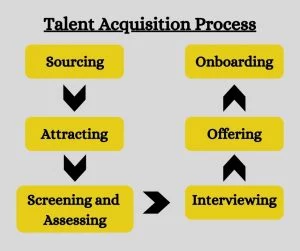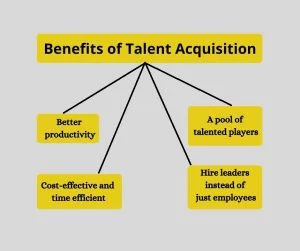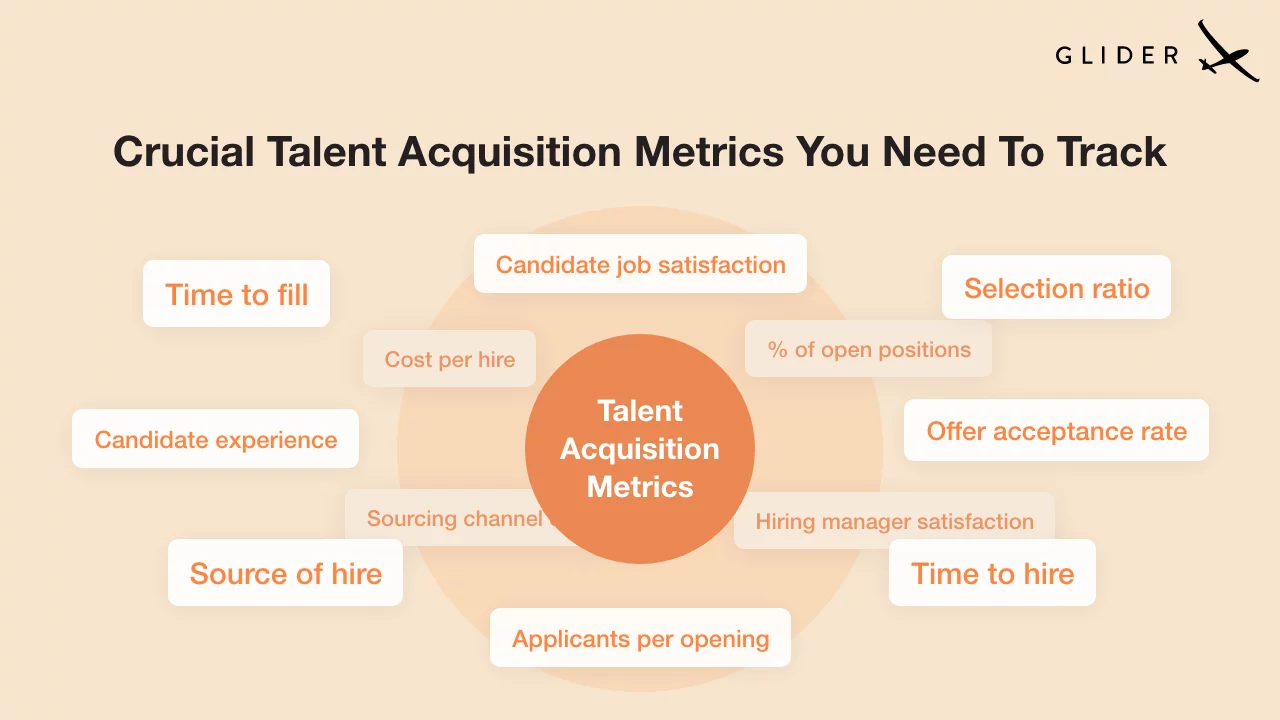With an enormous pool of talented candidates to choose from, it becomes hectic for the recruiting team to attract and hire the best and right talent. Talent acquisition may sound simple but it is a conjugated term that comprises a lot of metrics that need to be maintained for achieving sought-after results through the recruitment drives.
Before we count down all the metrics that need to be tracked, let’s first jump into the realm of talent acquisition and see what’s in store for us.
What is Talent Acquisition?
To put it in terms, talent acquisition means attracting, hiring, and eventually, retaining the best talent based on the requirements of the business.
According to Bill Gates,
“The key for us, number one, has always been hiring very smart people.”
There are many misinterpreted definitions regarding talent acquisition but, it is simply the process of acquiring the topmost workforce necessary for the success of the company.
Generally, in almost every company there is a talent acquisition team that manages and looks after the talent procurement process. The TA team forms up with HRs, recruiters, sources, and hiring managers. In the corporate world, this whole team comes under the umbrella of Human Resources.
Process of Talent Acquisition
Talent acquisition is a long and tiresome process and it takes months before the right talent is found out. But for the sake of writing, the whole process can be broken down into 6 simple steps.

- Sourcing: The TA team would surf the internet and keep a vigilant look on all the social media platforms and job boards to find the potential candidates and create a pool of talent with all the required qualities.
- Attracting: In this step, the team would attract potential talent with striking job descriptions and salary packages. They would try to create a good impression on the candidate for better engagement.
- Screening and Assessing: The team would perform a BGV and a CV screening process followed by assessing the candidates based on the job requirements. Nowadays, most of the assessments are done remotely through online assessment platforms.
- Interviewing: The filtered out candidates would undergo interviews where the recruiting team would evaluate their personality traits and their mindsets as per the workplace culture.
- Offering: The final candidates would receive the offer letters where all the details regarding the job and the workplace environment would be very meticulously described.
- Onboarding: This is the final step in the recruitment process. This step also requires the same amount of dedication and vigilance as all the other steps. The TA team needs to make sure that the onboarding process goes smoothly and does not degrade the candidate experience.
Importance of Talent Acquisition
The importance of talent acquisition can be traced from its name. It is the process of identifying and hiring the best employees that would fuel the productivity and result in the success of the company.
It is undeniable that without the best talent, a company cannot thrive. It is the people behind the company who are responsible for the betterment of it. The job of the TA team is to accumulate that driving force to uplift the company.
Moreover, talent acquisition isn’t simply filling up the vacant employee positions. It is a strategic process to hire the best employees who would work well with the company culture and continue to deliver the best for a foreseeable future. Thus, talent acquisition can be considered as a long-term investment plan that guarantees to provide the best ROI. The process maintains the quality of hire and also reduces the risk of hiring a bad fit for the company.

What are Talent Acquisition Metrics?
TA metrics are general measurements to evaluate the performance of the talent acquisition process and help the recruiters optimize the process to target the best employees. These are proven algorithms that determine the success of the recruiting process.
Talent Acquisition Metrics to Track
Based on the KPIs of different companies, the value for different metrics may not be similar. Here is a list of the most common metrics that every company will find useful for the measurement of the TA team performance.
- Time to Fill: Time to fill is the time it requires to fill the vacant position. It covers the whole duration starting from the position opening to the final onboarding. Time to fill may vary depending on the position to be filled and the speed of the recruiting team. It is affected by the supply and demand ratios based on the job. Measurement of the time to fill metric helps in finding any anomalies in the recruitment process.An average time to fill according to research is 36 days. The longest time to fill since 2010 has been 68 days.Unnecessary reduction of time to fill is not recommended but a fast and effective time to fill that upholds the quality is necessary.
- Time to Accept: It is the time that a candidate spends during the hiring process. Similar to the time to fill, time to hire may vary depending on the efficiency of the recruitment team. This metric is also known as “Time to Hire”.This metric if kept in check helps in providing better recruitment experience to the candidate, ultimately providing better results. If the process is simple and straightforward involving only a single interview, then it will take a shorter time to hire the candidate whereas if the process involves different screening, assessment, and interview steps than the time to hire would be longer.
- Cost per Hire: This metric determines the cost it takes to hire a single candidate. The cost per hire metric covers all the costs involved in the recruitment process. The TA team needs to measure this metric to determine the budget for the process.As per SHRM, the formula for calculating cost per hire is:The total cost of the recruitment process is divided by the total number of hires.
The math is simple; the longer it takes to hire, the costlier it gets. - Quality of Hire: Quality of hire measures the effectiveness of the new hire. It is a measurement that evaluates the productivity of the employee according to business goals and requirements. Quality of hire varies based on the requirements. It is measured by calculating the performance level of the employee, manager satisfaction, tenure, goals achieved, etc. This metric evaluates the validity and accountability of the hiring process. The higher the quality of hire, the better is the recruitment process. It is proportional to the success ratio, i.e., the number of quality hires divided by the total number of hires.
- Short-term Attrition Rate: Candidate retention rate indicates the success of the recruiting process. If a candidate leaves the job after a short period, it causes a great loss for the company. This turnover may be voluntary or involuntary. Whatever may be the case, a high attrition rate in the first year after the hire is an issue for the recruitment team and it needs attention.The higher the candidate retention rate, the better is the productivity. This metric is a great validation point for a successful recruitment process.
- Offer Acceptance Rate: An offer acceptance rate measures the number of candidates who accepted the offer amongst the total number of candidates who were offered the job. A low offer acceptance rate indicates that there may have been problems related to the compensation, job roles, requirements, etc. However, candidates may sometimes refuse the offer for various reasons that the team cannot control but still, this metric is an important factor that measures the recruitment process effectiveness.The higher the offer acceptance rate, the higher is the value of the process.
- Employee Satisfaction Rate: This rate measures how much the new hire is satisfied with the job. This metric tracks the match between the job description provided during the hiring process and the actual roles and responsibilities that are being performed by the employee.This metric is overlooked most times but it is a key indicator of the validity of the recruitment process.
- Source of Hire: Tracking the source of hire provides the effectiveness of the different sources from where the company is recruiting.This metric helps in checking the invaluable sources to the company, ultimately reducing the costs.To calculate the source of hire rate, divide the number of source hires by the number of external hires.
- Recruitment Effectiveness: The recruitment process effectiveness measures the yield ratio per step in the process. The higher the yield ratio, the better is the effectiveness of the process.The yield ratio is calculated by dividing the number of successful candidates from the stage by the number of total applicants for the stage.
- Productivity Rate: This metric measures the productivity of the new hire. The higher the rate of productivity, the better is the quality of hire. It is one of the main metrics that need to be measured from time to time.A low productivity rate hampers the success of the company.
These metrics are important to understand and evaluate the talent acquisition team’s efforts.
Hiring is a tough job and requires a lot of work. The company’s success depends on its employees. Thus, keeping these metrics in check will indicate the impact of talent acquisition in the betterment of the business.



